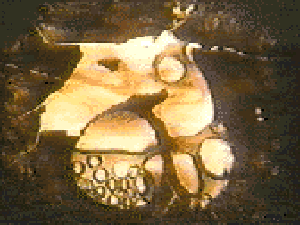
Some Recent Independent and Experimental Film 1991-1994
American Museum of the Moving Image
Curator: Mark McElhatten

"Dervish Machine creates images ancestrally linked to the mesmerizing ascensions that have always been one of the tropes of cinema since Kirchner's Magica Lanterna (an invention that gave cardiac pause to Jesuits and poltergeist alike) unleashed phantasmagoric images onto billowing clouds of smoke.
Since then a more anthracite cinema (equally magical) has taken place but one still inhales/exhales with risings and fallings. Out of that nebulous smoke and the remains of ash (has no one ever linked the word cinema with cinerarium the place where ashes are stored in crematoria) have followed countless resurrections and reanimations.
The suspended figure, above rooftops or celestially assumed, echo throughout cinema, from the films of Melies to Dreyer, on into Pasolini and most recently Ruiz. Dervish Machine may have it's closext antecedents in the Chagall-like midair suspensions witnessed in the films of Yuri Ilyenko (the dervish cinematography of Paradjanov's Shadows of Our Forgotten Ancestors is also Ilyenko's work) and the Tintoretto-like levitations of Jack Smith perched atop wormwood-eaten tombstones on tiptoe as he seems to move skyward in Ken Jacobs' Death of P'Town.
. The homespun chemical processing that the Dervish Machine has been cured in creates a contusion that mortally jars and unbridles the flesh of the film. The pellicular force within the emylsions rise and the anterior comes to life, respiring onscreen in dizzying splendor. Dervish Machine is both a dare and a caution sign. It contains the lesson also put forth in The Sorcerer's Apprentice. The illusions that hold us in sway can also be harnessed, but they cannot be controlled indiscriminately. In quoting from the Japanese supernatural film classic Onibaba, Dervish Machine reminds us that illusion may hold us for ransom and sever us from our identity if we fail to respect the power of the unknown.
Dervish Machine is also a hymn to intermittency. Intermittency is
the optical coitus interruptus/continuum that perpetuates film as a species
and as an illusion. Gysin's Dreamachine is simply a modified spinning top
of cutouts that interrupts light and brain waves, lowering the drawbridge
betwwen subject and object. Dervish Machine is a narrativized Dreamachine,
a Scheherezadean machine spinning tales and turning tides.
Narrative wasn't laminated onto cinema, uncontrollably film hemorrahaged and secreted a story at the onset., in the early spring of it's maturity. The Lumieres fritted that their invention was without a future (their first presentations were for select scientific conferences where the cinematograph was offered as icing on the cake or a side show to their more highly esteemed color and stereoptical experiments) but futures are no more easily aquired than predicted. Part of the story ingrained in cinema is its indefinite existence, its unexpected continuation.
Looks can kill. Yet in filming anything under the sun an instant memorialization takes place. Edison feared the phonograph would be regarded as mere toy. Kenneth Anger declared that the cinematograph is a divine weapon. And as we know, toys and weapons have often imitated each other. Thus Dervish Machine reminds us that the cinema is a ferris wheel, a zoetrope, and a time bomb.
--Mark McElhatten, catalog notes for 'Burning in the Gate' , AMMI